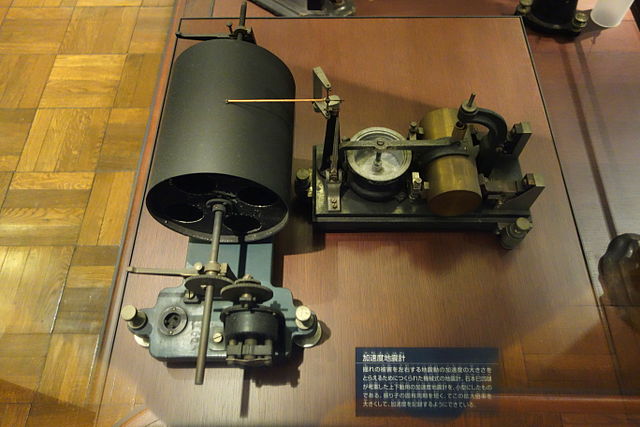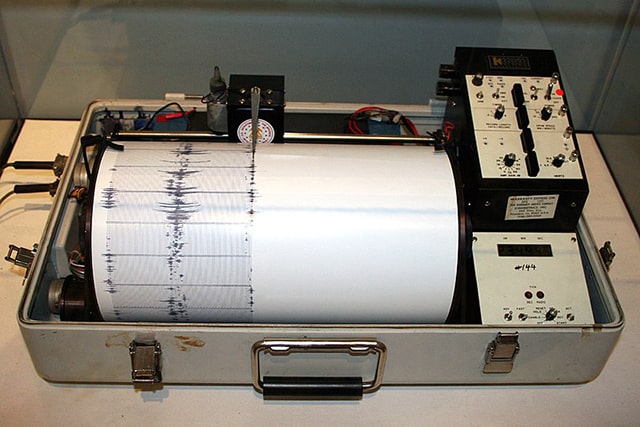Lesson 42 Recording and earthquake记录地震
First listen and then answer the following question: What does a pen have to do to record on paper the vibrations generated by an earthquake?
An earthquake comes like a thief in the night, without warning. It was necessary, therefore, to invent instruments that neither slumbered nor slept. Some devices were quite simple. One, for instance, consisted of rods of various lengths and thicknesses which would stand up on end like ninepins. When a shock came, it shook the rigid table upon which these stood. If it were gentle, only the more unstable rods fell. If it were severe, they all fell. Thus the rods, by falling, and by the direction in which they fell, recorded for the slumbering scientist the strength of a shock that was too weak to waken him, and the direction from which it came.
But instruments far more delicate than that were needed if any really serious advance was to be made. The ideal to be aimed at was to devise an instrument that could record with a pen on paper, the movements of the ground or of the table as the quake passed by. While I write my pen moves, but the paper keeps still. With practice, no doubt, I could in time learn to write by holding the pen still while the paper moved. That sounds a silly suggestion, but that was precisely the idea adopted in some of the early instruments (seismometers) for recording earthquake waves. But when table, penholder and paper are all moving, how is it possible to write legibly? The key to a solution of that problem lay in an everyday observation. Why does a person standing in a bus or train tend to fall when a sudden start is made? It is because his feet move on , but his head stays still. A simple experiment will help us a little further. Tie a heavy weight at the end of a long piece of string. With the hand held high in the air, hold the string so that the weight nearly touches the ground. Now move the hand to and fro and around but not up and down. It will be found that the weight moves but slightly or not at all. Imagine a pen attached to the weight in such a way that its point rests upon a piece of paper on the floor. Imagine an earthquake shock shaking the floor, the paper, you and your hand. In the midst of all this movement, the weight and the pen would be still. But as the paper moved from side to side under the pen point, its movement would be recorded in ink upon its surface. It was upon this principle that the first instruments were made, but the paper was wrapped round a drum which rotated slowly. As long as all was still, the pen drew a straight line, but while the drum was being shaken, the line that the pen was drawing wriggled from side to side. The apparatus thus described, however, records only the horizontal component of the wave movement, which is, in fact, much more complicated. If we could actually see the path described by a particle, such as a sand grain in the rock, it would be more like that of a bluebottle buzzing round the room; it would be up and down, to and fro and from side to side. Instruments have been devised and can be so placed that all three elements can be recorded in different graphs.
When the instrument is situated at more than 700 miles from the earthquake centre, the graphic record shows three waves arriving one after the other at short intervals. The first records the arrival of longitudinal vibrations. The second marks the arrival of transverse vibrations which travel more slowly and arrive several minutes after the first. These two have travelled through the earth. It was from the study of these that so much was learnt about the interior of the earth. The third, or main wave, is the slowest and has travelled round the earth through the surface rocks.
H. H. SWINNERTONThe Earth beneath Us


与课文关联的单词
earthquake
//n. 地震slumber
//v. 睡眠ninepin
/ˈnaɪnˌpɪn/n. 九柱戏中的木柱rigid
//adj. 坚硬的delicate
/ˈdelɪkət/adj. 灵感的seismometer
//n. 地震仪penholder
//n. 笔杆legibly
/ˈledʒəbli/adv. 字迹清楚地drum
/drʌm/n. 鼓状物wriggle
//v. 扭动bluebottle
//n. 绿头苍蝇graph
//n. 图表graphic
//adj. 图示的longitudinal
/ˌlɒŋɡɪˈtjuːdən(ə)l/adj. 纵向的transverse
//adj. 横向的笔记更新中
如果您看到了此提示,说明本课笔记还在正在努力更新中,请持续关注,我们将尽力把课文中出现的重点知识点总结出来!引子 更新于:2024-07-13 01:54:41
An earthquake comes like a thief in the night, without warning. It was necessary, therefore, to invent instruments that neither slumbered nor slept. Some devices were quite simple. One, for instance, consisted of rods of various lengths and thicknesses which would stand up on end like ninepins. When a shock came, it shook the rigid table upon which these stood. If it were gentle, only the more unstable rods fell. If it were severe, they all fell. Thus the rods, by falling, and by the direction in which they fell, recorded for the slumbering scientist the strength of a shock that was too weak to waken him, and the direction from which it came.
转折 更新于:2024-07-13 01:58:14
But instruments far more delicate than that were needed if any really serious advance was to be made.
The ideal to be aimed at was to devise an instrument that could record with a pen on paper, the movements of the ground or of the table as the quake passed by.
While I write my pen moves, but the paper keeps still.
With practice, no doubt, I could in time learn to write by holding the pen still while the paper moved.
That sounds a silly suggestion, but that was precisely the idea adopted in some of the early instruments (seismometers) for recording earthquake waves.
But when table, penholder and paper are all moving, how is it possible to write legibly?
The key to a solution of that problem lay in an everyday observation.
Why does a person standing in a bus or train tend to fall when a sudden start is made? It is because his feet move on , but his head stays still.
A simple experiment will help us a little further. Tie a heavy weight at the end of a long piece of string.
With the hand held high in the air, hold the string so that the weight nearly touches the ground.
动作 更新于:2024-07-13 01:57:33
Now move the hand to and fro and around but not up and down. It will be found that the weight moves but slightly or not at all. Imagine a pen attached to the weight in such a way that its point rests upon a piece of paper on the floor. Imagine an earthquake shock shaking the floor, the paper, you and your hand. In the midst of all this movement, the weight and the pen would be still. But as the paper moved from side to side under the pen point, its movement would be recorded in ink upon its surface. It was upon this principle that the first instruments were made, but the paper was wrapped round a drum which rotated slowly. As long as all was still, the pen drew a straight line, but while the drum was being shaken, the line that the pen was drawing wriggled from side to side. The apparatus thus described, however, records only the horizontal component of the wave movement, which is, in fact, much more complicated. If we could actually see the path described by a particle, such as a sand grain in the rock, it would be more like that of a bluebottle buzzing round the room; it would be up and down, to and fro and from side to side. Instruments have been devised and can be so placed that all three elements can be recorded in different graphs.
结论 更新于:2024-07-13 01:59:07
When the instrument is situated at more than 700 miles from the earthquake centre, the graphic record shows three waves arriving one after the other at short intervals.
The first records the arrival of longitudinal vibrations.
The second marks the arrival of transverse vibrations which travel more slowly and arrive several minutes after the first.
These two have travelled through the earth. It was from the study of these that so much was learnt about the interior of the earth.
The third, or main wave, is the slowest and has travelled round the earth through the surface rocks.